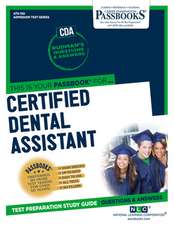Machine Learning in Dentistry
Editat de Ching-Chang Ko, Dinggang Shen, Li Wangen Limba Engleză Hardback – 25 iul 2021
| Toate formatele și edițiile | Preț | Express |
|---|---|---|
| Paperback (1) | 582.32 lei 39-44 zile | |
| Springer International Publishing – 26 iul 2022 | 582.32 lei 39-44 zile | |
| Hardback (1) | 846.12 lei 39-44 zile | |
| Springer International Publishing – 25 iul 2021 | 846.12 lei 39-44 zile |
Preț: 846.12 lei
Preț vechi: 890.65 lei
-5% Nou
Puncte Express: 1269
Preț estimativ în valută:
161.92€ • 169.26$ • 136.83£
161.92€ • 169.26$ • 136.83£
Carte tipărită la comandă
Livrare economică 03-08 martie
Preluare comenzi: 021 569.72.76
Specificații
ISBN-13: 9783030718800
ISBN-10: 3030718808
Pagini: 188
Ilustrații: X, 188 p. 90 illus., 76 illus. in color.
Dimensiuni: 178 x 254 mm
Greutate: 0.59 kg
Ediția:1st ed. 2021
Editura: Springer International Publishing
Colecția Springer
Locul publicării:Cham, Switzerland
ISBN-10: 3030718808
Pagini: 188
Ilustrații: X, 188 p. 90 illus., 76 illus. in color.
Dimensiuni: 178 x 254 mm
Greutate: 0.59 kg
Ediția:1st ed. 2021
Editura: Springer International Publishing
Colecția Springer
Locul publicării:Cham, Switzerland
Cuprins
Machine Learning for Dental Imaging: Machine Learning for CBCT Segmentation of Craniofacial 3D Image.- Machine Learning for Automatic Landmark Detection of 3D Imaging.- Machine Learning for Generating Dental CT from Magnetic Resonance Imaging (MRI).- Machine Learning for 2D Dynamic Facial Photographs. Machine Learning for Oral Diagnosis and Treatment: Machine Learning for Orthodontic Diagnosis and Treatment Planning.- Machine Learning for Diagnosis of Periodontal Diseases.- Machine Learning for Oral Microbiome.- Machine Learning for Characterization of Craniofacial Anomaly.- Machine Learning for Orthognathic Surgery.- Machine Learning for Bone Tissue Engineering. Machine Learning and Dental Designs: Machine Learning for Orthodontic CAD/CAM Technologies.- Machine Learning for Design of Dental Implants.- Machine Learning for Optimization of Dental Material Processing. Machine Learning Supporting Dental Research: Machine Learningfor Data Mining in Teledentistry.- Machine Learning for Evidence-Based Literature Search.- Machine Learning in Genetics and Genomics.- Machine Learning and Finite Element Modeling.
Notă biografică
Ching-Chang Ko, DDS, MS, PhD, is Professor and Vig/William Endowed Chair of the Division of Orthodontics, College of Dentistry at the Ohio State University, Columbus, OH, USA. Dr. Ko graduated in Dentistry from Kaohsiung Medical College in Taiwan in 1984 and subsequently gained his MS in Bioengineering at National Yang-Ming University and his PhD in Bioengineering and Biomaterials at the University of Michigan. He completed his Certificate in Orthodontics at the University of Minnesota in 2006. He has been Professor of Orthodontics at University of North Carolina 2006-2019 and served as Program Director since 2013 and Chair 2017-2019. He moved to Ohio State University in 2020 to join the Division of Orthodontics and the Translational Data Analytics Institute to develop Artificial Intelligence in Orthodontics. In 2017 Dr. Ko was also a Guest Professor at Peking University in China. Dr. Ko is the author of 150 peer-reviewed journal articles. He is an Associate Editor forThe Angle Orthodontist and an editorial board member of the Chinese Journal of Orthodontics and acts as a reviewer for numerous journals. NIH, NSF, Whitaker Foundation, NC Biotech, and companies (e.g., 3M /ESPE, Smartee Inc., N2Bio) have supported his research, in part. He is Member of International Association for Dental Research (IADR) and American Association of Orthodontists (AAO).
Dinggang Shen, PhD, FIEEE, FAIMBE, FIAPR, is Professor and Dean of School of Biomedical Engineering, ShanghaiTech University, and also Co-CEO of United Imaging Intelligence (UII). He is Fellow of IEEE, Fellow of The American Institute for Medical and Biological Engineering (AIMBE), Fellow of The International Association for Pattern Recognition (IAPR), and also Fellow of The Medical Image Computing and Computer Assisted Intervention (MICCAI) Society. He was Jeffrey Houpt Distinguished Investigator, and (Tenured) Full Professor in the University of NorthCarolina at Chapel Hill (UNC-CH). His research interests include medical image analysis, computer vision, and pattern recognition. He has published more than 1100 peer-reviewed papers in the international journals and conference proceedings, with H-index 107. He serves as an editorial board member for eight international journals. Also, he has served in the Board of Directors, The Medical Image Computing and Computer Assisted Intervention (MICCAI) Society, in 2012-2015, and was General Chair for MICCAI 2019.
Li Wang, BS, PhD, is an Assistant Professor in the Department of Radiology and Biomedical Research Imaging Center at the University of North Carolina at Chapel Hill. He is the director of Developing Brain Computing Lab. He joined the University of North Carolina at Chapel Hill as a postdoctoral research fellow in 2010, after gaining his doctorate in Pattern Recognition and Intelligent Systems from Nanjing University of Science and Technology, and took up hispresent post in 2015. Dr. Wang’s research focuses on the development of innovative computational methods and tools for processing and analyzing medical imaging data. Among his achievements are the creation of a comprehensive set of advanced CBCT-dedicated tools for processing CBCTs for patients with craniomaxillofacial deformities. He has been lead or co-author of 76 articles in peer-reviewed journals and has an H-index of 40. He acts as a reviewer for numerous journals. He is a senior member of the IEEE..
Dinggang Shen, PhD, FIEEE, FAIMBE, FIAPR, is Professor and Dean of School of Biomedical Engineering, ShanghaiTech University, and also Co-CEO of United Imaging Intelligence (UII). He is Fellow of IEEE, Fellow of The American Institute for Medical and Biological Engineering (AIMBE), Fellow of The International Association for Pattern Recognition (IAPR), and also Fellow of The Medical Image Computing and Computer Assisted Intervention (MICCAI) Society. He was Jeffrey Houpt Distinguished Investigator, and (Tenured) Full Professor in the University of NorthCarolina at Chapel Hill (UNC-CH). His research interests include medical image analysis, computer vision, and pattern recognition. He has published more than 1100 peer-reviewed papers in the international journals and conference proceedings, with H-index 107. He serves as an editorial board member for eight international journals. Also, he has served in the Board of Directors, The Medical Image Computing and Computer Assisted Intervention (MICCAI) Society, in 2012-2015, and was General Chair for MICCAI 2019.
Li Wang, BS, PhD, is an Assistant Professor in the Department of Radiology and Biomedical Research Imaging Center at the University of North Carolina at Chapel Hill. He is the director of Developing Brain Computing Lab. He joined the University of North Carolina at Chapel Hill as a postdoctoral research fellow in 2010, after gaining his doctorate in Pattern Recognition and Intelligent Systems from Nanjing University of Science and Technology, and took up hispresent post in 2015. Dr. Wang’s research focuses on the development of innovative computational methods and tools for processing and analyzing medical imaging data. Among his achievements are the creation of a comprehensive set of advanced CBCT-dedicated tools for processing CBCTs for patients with craniomaxillofacial deformities. He has been lead or co-author of 76 articles in peer-reviewed journals and has an H-index of 40. He acts as a reviewer for numerous journals. He is a senior member of the IEEE..
Textul de pe ultima copertă
This book reviews all aspects of the use of machine learning in contemporary dentistry, clearly explaining its significance for dental imaging, oral diagnosis and treatment, dental designs, and dental research. Machine learning is an emerging field of artificial intelligence research and practice in which computer agents are employed to improve perception, cognition, and action based on their ability to “learn”, for example through use of big data techniques. Its application within dentistry is designed to promote personalized and precision patient care, with enhancement of diagnosis and treatment planning. In this book, readers will find up-to-date information on different machine learning tools and their applicability in various dental specialties. The selected examples amply illustrate the opportunities to employ a machine learning approach within dentistry while also serving to highlight the associated challenges. Machine Learning in Dentistry will be of value for all dental practitioners and researchers who wish to learn more about the potential benefits of using machine learning techniques in their work.
Caracteristici
Reviews use of machine learning in contemporary dentistry Covers applications in dental practice and research Highlights benefits, opportunities, and challenges














